

| Identifying Nottinghamshire's Eriocrania leaf mines |
| ............... |
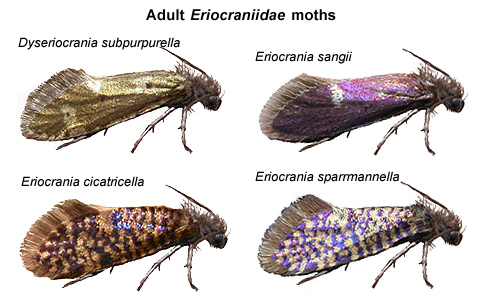 |
The Eriocranias represent
one of the identification challenges facing anyone
embarking on an interest in our under recorded micro
moths. With the possible exception of the recently renamed Dyseriocrania subpurpurella, the correct identification of the adults requires some skill with a scalpel and the use of a microscope, examining the genitalia in order to confirm identity. However, all UK Eriocranias are easily identifiable without resorting to genitalia dissection (gen det) simply by keying out the leaf mine using a combination of characteristic features. This page should help the inexperienced observer, with the identification of Eriocrania mines found on Birch (six species) and Oak (one species). |
| ............... | ||
| Nottinghamshire
species There are currently seven of the UK's eight known species of Eriocrania on the Nottinghamshire micro moth species list. Eriocrania chrysolepidella is the only absentee from the Nottinghamshire list we originally compiled in late 2013. The scarcest of the eight species, E. chrysolepidella has a localised distribution in parts of the southern UK, although there are isolated records from counties north of Nottinghamshire. This could be one of the many over-looked micro moths, waiting to be discovered in some east Nottinghamshire woodland where Hazel grows plentifully. |
||
| ............... | ||
| At the opposite extreme,
our commonest species is Dyseriocrania subpurpurella
- found virtually anywhere where there is Oak. Young
trees planted in parks and urban areas, will usually show
D. subpurpurella leaf mines a year or so after
planting and counts of adults can literally be in their
hundreds in mature Oak woodland. The usually pure metallic gold colour of D. subpurpurella, does help to distinguish it from all our other species by sight, but occasional specimens can be flecked with scales of purple, causing confusion with our other species, so the identification of most adult Eriocranias, is best left to dissection to confirm. Dyseriocrania subpurpurella is the only species where the larva mines the leaves of Oak. All the others (with the exception of Eriocrania chrysolepidella on Hazel) feed on Birch. Therefore, the problem of identifying any Eriocrania mine found on Birch, has already been reduced by two species, leaving just the six. |
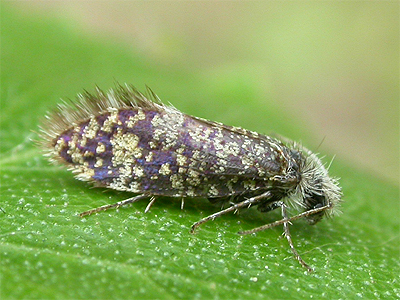 |
|
| 2.001 ... B&F
0006 Dyseriocrania subpurpurella (Haworth, 1828) |
||
| Foodplant ... Oak (Quercus) | ||
| Occupied mine found ... May and June | ||
| Mine description ... The mine is a typical large blotch mine on Oak, with the frass usually produced into long threads. The larva is white, with a light brown head. One larva per mine. | ||
| .... | ||
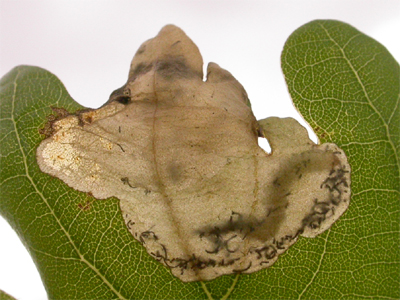 |
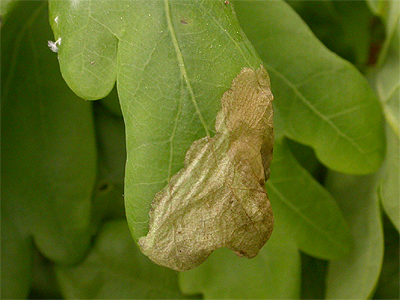 |
|
| 2.003 ... B&F
0008 Eriocrania unimaculella (Zetterstedt, 1839) |
||
| Foodplant ... Birch (Betula) | ||
| Occupied mine found ... April - May | ||
| Mine description ... The mine starts at or near the edge of the leaf, widening into a blotch with the frass in long threads. The final instar larva has a dark brown head. One larva per mine. | ||
| .... | ||
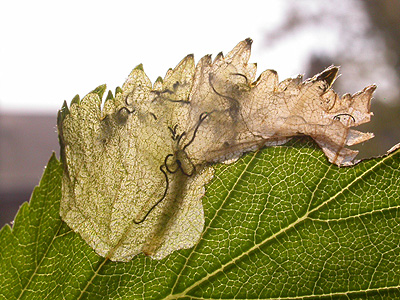 |
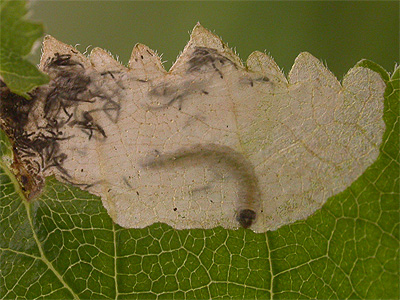 |
|
| 2.004 ... B&F
0009 Eriocrania sparrmannella (Bosc, 1791) |
||
| Foodplant ... Birch (Betula) | ||
| Occupied mine found ... June - August | ||
| Mine description ... The gallery begins in centre of leaf and eventually becomes absorbed into an angular blotch towards the edge of the leaf. The final instar larva is white, with the head brown. One larva per mine. | ||
| .... | ||
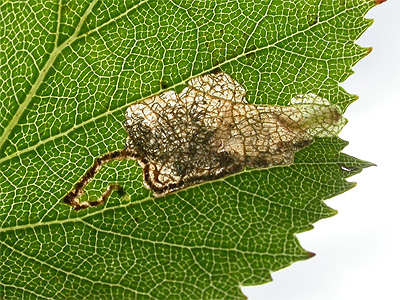 |
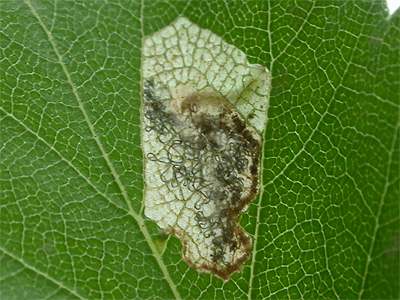 |
|
| 2.005 ... B&F
0010 Eriocrania salopiella (Stainton, 1854) |
||
| Foodplant ... Birch (Betula) | ||
| Occupied mine found ... May - June | ||
| Mine description ... The early gallery starts as a linear mine in the centre of the leaf, widening into a large blotch as it approaches the leaf edge. The frass in long threads. One larva per mine. | ||
| .... | ||
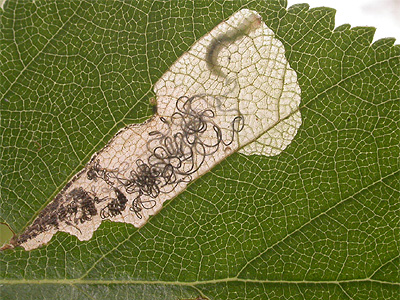 |
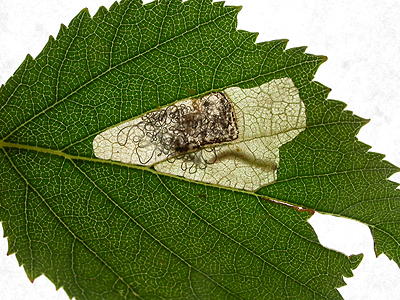 |
|
| 2.006 ... B&F
0011 Eriocrania cicatricella (Zetterstedt, 1839) |
||
| Foodplant ... Birch (Betula) | ||
| Occupied mine found ... May | ||
| Mine description ... A blotch mine is formed, usually clouded by green matter left in mine. There is usually more than one larva (2-4) per mine. | ||
| .... | ||
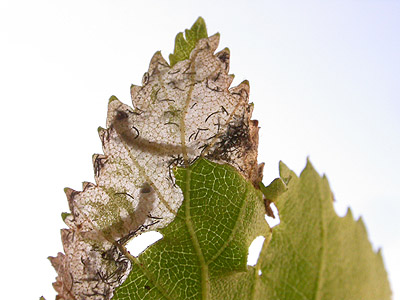 |
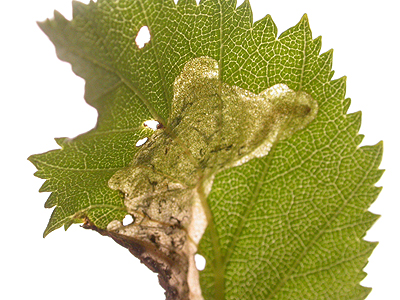 |
|
| 2.007 ... B&F
0013 Eriocrania semipurpurella (Stephens, 1835) |
||
| Foodplant ... Birch (Betula) | ||
| Occupied mine found ... April - May | ||
| Mine description ... The mine starts at (or near) the leaf edge, widening into a large blotch. One larva per mine. | ||
| .... | ||
 |
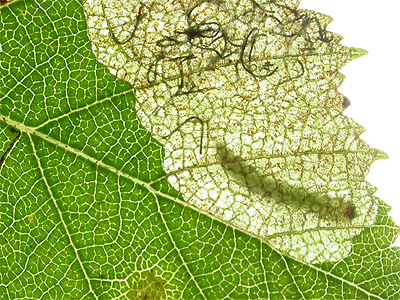 |
|
| 2.008 ... B&F
0012 Eriocrania sangii (Wood, 1891) |
||
| Foodplant ... Birch (Betula) | ||
| Occupied mine found ... April - May | ||
| Mine description ... Probably one of the easiest of the Birch feeding Eriocranias to identify. A blotch mine is formed by a single, grey larva at the edge of the leaf. One larva per mine. | ||
| .... | ||
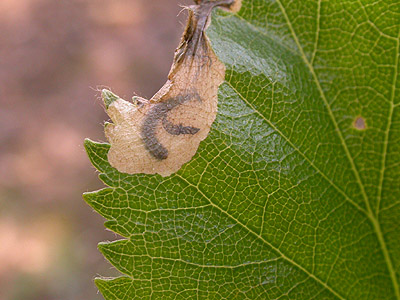 |
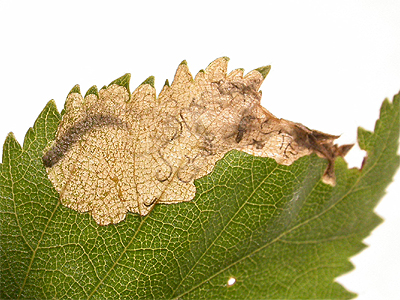 |
|